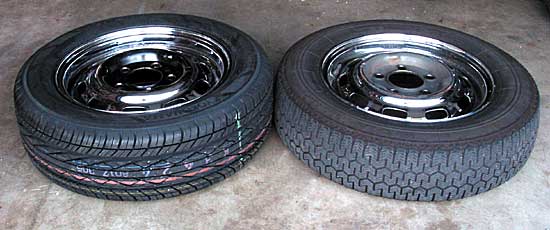



Tires The standard tire for 1965-1969 912s were 165R15 on 4.5 in. steel rims. 5.5 in. steel rims appeared in 1968. 1969 had some other factory options including 185VR15 on 6 in. rims and 185HR14 on 5.5 in. rims. I upgraded to fatter tires this week using some 5.5 in. steel rims picked up at Parts Heaven last week. Forged Fuchs alloys were optional starting in 1967. We considered getting Fuchs, but have decided to wait. Tire RubbingTire PressuresThis table shows factory standard and optional wheels and tires that were available on various 912 cars.
The wheels are stamped with sizes and dates. Fuchs AlloysThe forged aluminum alloy Fuchs wheel was the only alloy available for many years on Porsches. It first appeared in 1967 standard on the 911S and optional on other models in a 4.5 in. x 15 size. It went to 5.5 in. in 1968 and some 6 in. x 15 were available in 1969. There was a 5.5 in. x 14 variant in 1969. The 6 x 15 was offered in two versions distinguished by differing offset and the step-down which allows tire mounting. The earlier one has more offset and a step-down further from the outer rim edge. Tires should be mounted from the back of the rim on this rim. Mounting is difficult on these and high performance tires are particularly hard because of extra reinforcement in the head and sidewall. In 1972 a new design was introduced with less offset. There were several variants of center hub sizes leading to differences in cap sizes. Yokohama Avid H4 TiresThe tires are asymmetrical. There is an arrow on the tire indicating the correct rotation direction. Be sure to check after they are mounted that all four wheels rotate in the direction of the arrow. Features of this tire:
Yokohama Factory specifications:
The table is from the Yokohama web site. Comparison of the Old and New Rim/Tire Combination
Notes:
|

